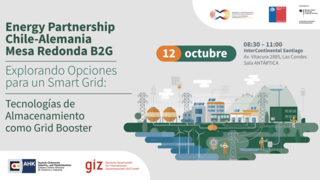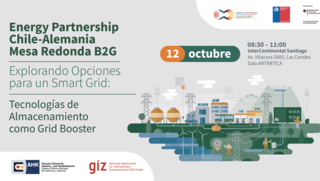15th Roundtable B2G (grid booster)

"Exploring Smart Grid Options: Storage Technologies like the Grid Booster"
Within the framework of the Energy Partnership Chile-Alemania, a Business-to-Government round table was held on the options for a Smart Grid. On this occasion, we had the participation of the German Federal Ministry of Economics and Climate Protection, the Chilean National Electricity Coordinator, the Energy Center of University of Chile and the Chilean Association of Alternative Renewable Energy (ACERA), as well as the German TSO Transnet BW presenting a Grid Booster pilot project in Germany.
More detailed information you can find in the download section at the end of the document.
Annika Schüttler, Project Leader Energy & Sustainability at AHK Chile moderated the event. It started with welcoming remarks by Dr Georg Maue, focal point for Energy and Climate Partnerships with Latin America at the Federal Ministry for Economy and Climate Action (BMWK), who addressed the question "How to bring 100% RE into the grid?" The “Energiewende”, Germanys long-term energy and climate strategy, adopts ambitious measures to achieve climate neutrality by 2045; one prerequisite is reaching the target of 80% renewable electricity consumption by 2030, and a target of 100% aspired by 2035. This also requires an expansion of the German electricity grid and even better interconnection with its European neighbours. 119 grid expansion projects are currently in progress. Smart grids together with intelligent storage systems ─ like large batteries, large pumped storage systems, and many small swarm batteries in private households – will provide the necessary flexibility and stability. In addition to the falling prices for batteries, the BMWK is also counting on gigawatt capacities of hydrogen-ready power plants that will go into operation in the beginning of the next decade.
Following this introduction, two experts contributed valuable insights on storage technology and its application in the Chilean context. Carlos Benavides from the Centro de Energía (University of Chile) started by presenting "Tecnologías de almacenamiento en Chile" (storage technologies in Chile), where he classified different storage types according to materials, costs, storage duration, and whether they are designed as stand-alone solutions or combined with other renewable energy systems. The Energy Centers’ projection for a decarbonized electricity matrix in Chile defined a requirement of 4 to 5 GW storage capacity in order to be able to function solely, without using coal and gas as power sources for the nighttime.
Further conclusions by Centro de Energía:
- Best known technologies at the national level: hydroelectricity, BESS (battery energy storage system), CSP (concentrated solar plant), pump storage, Carnot batteries
- There is uncertainty in estimating investment costs, but CSP and pump storage have the lowest development costs.
- Hybrid projects make BESS type projects more competitive.
- In general, storage systems have higher costs than wind and solar photovoltaic renewable technologies.
- Required storage capacity depends on:
- Retirement of thermoelectric power plants
- End-use electrification
- Renewable resource distribution
- Peak demand increase
- Demand side management
- Energy efficiency
Juan Carlos Araneda, Assistant Manager Network Planning and Development, then spoke on behalf of the Coordinador Eléctrico Nacional, the Chilean independent system operator (ISO). Araneda introduced the characteristics of the Chilean electricity grid being its extension over a very long geography and, in contrast to the European grid, not being interconnected with the systems of neighbouring countries. The governments long-term energy planning foresees rising demand, which is to be increasingly covered by volatile generation from wind and solar power. However, the mining operations, particularly in the north, require stable base load, which has so far mainly been supplied by coal-fired power plants. A study by the independent system operator identified the optimal location, capacity and duration of long-term storage systems in the national grid, with a focus on the northern zone (Polpaico to the north), that minimize the cost of investment, operation and maintenance of the system in the 2025-2032 horizon. One finding of the study is that the cost of the decarbonization process with investment in batteries can be even lower than the conventional generation based on fossils.
The results indicate the following results for the storage systems:
- Location mostly in the far north, consistent with high installed capacity and concentration of large consumers.
- Durations in the range of 6 to 8 hours attending to the expected oversupply of energy in solar hours.
- Installed capacity between 1,000-4,000 MW in the period 2026-2032.
- For an energy transition towards 100% renewable systems, it is required that storage systems have attributes that give strength to the grid, such as grid forming features, ramp control, black start, among others.
Following these two inputs, Jonas Lotze, Project Manager Strategic Grid Development from the German TSO TransnetBW presented a Grid Booster pilot project in Germany, stating that numerous interconnectors integrate the south German TransnetBW grid into the German and European transmission system. The Grid booster technology is a supporting battery system that enables a higher utilization of grid infrastructure by utilizing existing n-1 contingency reserves and maintaining the same security level. The pilot project consists of a battery system of 250 MW for 1h with connection to the HV-Substation Kupferzell, which will enable higher wind power transports from the north to the south. A communication system between the wind farm in the North of Germany and TransnetBW Control Centre in Wendlingen in the south is part of the project. The payback is expected within 11 years, as costs for redispatch and curtailment of wind power will be saved.
Finally, on behalf of the Chilean Renewable Energy Association ACERA, Executive Director Ana Lia Rojas spoke about the need to work on a smart grid in Chile to enable the energy transition. According to ACERA, around USD 2 billion will need to be invested in batteries in the north of Chile by 2026 in order to be able to store the renewable energy that has so far been lost due to curtailment, caused by power grid bottlenecks. Ana Lia Rojas also identified a need for action in the regulation of net billing and distribution law to create fair market access for new players and incentives for new, necessary services. ACERA‘s key points:
- The relationship between the smart grid and renewable energy revolves around data collection.
- (Green) Mining is crucial to enable the development of innovative technologies.
- Smart grids reduce electricity consumption.
Watch the presentations and the discussion on options for a smart grid in the following panel in the video below.
Video: Mesa Redonda B2G | Smart Grid

Presentations
- BMWK: "How to bring 100% RE into the grid" (1 MB, PDF)
- Centro de Energía: "Tecnologías de almacenamiento en Chile" (2 MB, PDF)
- Coordinador Eléctrico Nacional: "Estudio de almacenamiento de energía en el SEN" (2 MB, PDF)
- TransnetBW: "Grid booster Pilot" (1 MB, PDF)
- ACERA: "Energías Renovables en una Smart Grid" (3 MB, PDF)
- AHK/GIZ: "Factsheet Smart Grids" (742 KB, PDF)
The Chilean-German Energy Partnership officially started in April 2019, when the German Federal Ministry of Economics and Climate Action (BMWK) and the Chilean Ministry of Energy (MEN) signed an Agreement of Cooperation. This partnership has a full-time secretariat in Santiago de Chile operated by Deutsche Gesellschaft für Internationale Zusammenarbeit (GIZ)GmbH which is the implementing body of this project.